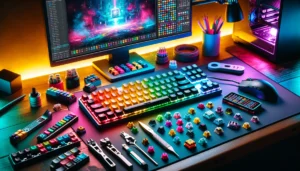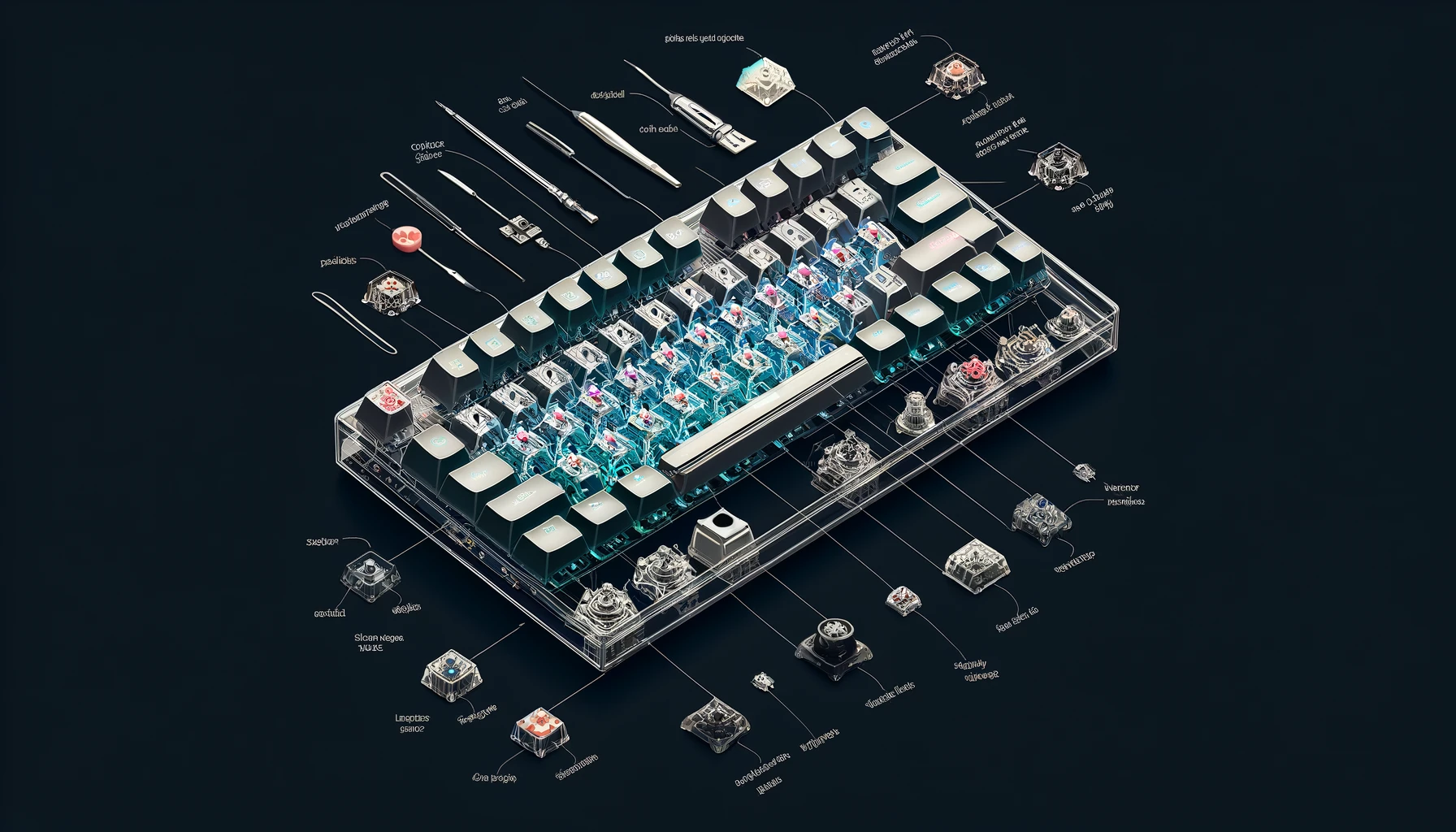What Is a Mechanical Keyboard?
What Is a Mechanical Keyboard?

Table of Contents
If you’ve been around a computer for any time, you’ve encountered What Is a Mechanical Keyboard. If you haven’t heard these terms before, don’t worry—you’re not alone! Let’s start by understanding why the interest in mechanical keyboards has grown and why they are becoming the go-to choice for gamers, programmers, typists, and even your everyday office worker.
Mechanical keyboards are built differently from their membrane counterparts. Their distinctive switch technology offers a unique typing experience loved for its tactile feedback and satisfying sound. With the rise of customization options and quality materials, the modern mechanical keyboard is a remarkable tool worth exploring. This article will walk you through everything you need to know, from understanding the anatomy of these keyboards to choosing the best one for your needs.
Mechanical Keyboards

What Makes a Keyboard Mechanical?
The switches beneath each key define a mechanical keyboard at its core. A rubber dome or membrane layer registers a keypress in a traditional membrane keyboard. In contrast, a mechanical keyboard uses individual mechanical switches that rely on springs, metal contacts, and other mechanical components. Unlike membrane keyboards that use rubber domes to push against a circuit board, mechanical keyboards have switches connected directly to the circuit board, registering keystrokes with a metal spring and stem for enhanced durability and longevity.
Each switch type has a distinct feel and sound, which gives users a unique typing experience based on their preferences. While membrane keyboards are known for being quieter and more affordable, mechanical keyboards have distinct advantages like longevity, tactile feedback, and superior customization options.
Distinctive Features of Mechanical Keyboards
Switch Technology: Mechanical keyboards stand out due to their unique key switches, the heart of their distinctive typing experience. These key switches come in various types, each with specific attributes like tactile feedback, actuation point, and the materials used in their construction, contributing to the keyboard’s overall feel and performance. They can be classified into three main categories: linear, tactile, and clicky. This variety allows users to choose a switch that best suits their typing style and preference. For instance, gamers might lean towards linear switches for their swift actuation, while typists may favor tactile or clicky switches for the substantial feedback they provide.
Build Quality and Materials: Mechanical keyboards are usually sturdier than membrane ones. Many feature aluminum frames or thick plastic cases for a more substantial feel, whereas membrane keyboards often prioritize cost over durability. In addition, keycaps in mechanical keyboards are often made of premium materials like PBT plastic, which is more durable and resistant to wear than the ABS plastic commonly used in membrane keyboards.
Benefits Of Membrane Keyboards
Durability: Mechanical keyboards are designed to last longer. The switches are often rated for millions of keystrokes, making them more suitable for heavy usage than the membrane switches, which tend to wear out much quicker.
Tactile Feedback: Mechanical switches offer feedback that helps improve typing accuracy. For instance, tactile and clicky switches have a bump or audible click that indicates the keypress has been registered. This gives users a clear indication of their typing, reducing errors and improving the overall experience.
Customization: Mechanical keyboards excel in customization, allowing you to tailor the experience to your preferences. Hot-swappable models let you change the switch type without soldering, while aftermarket keycap sets enable you to modify the keyboard’s look and feel. Some models also offer customizable RGB lighting, which can be programmed per key.
Mechanical keyboards provide a reliable and enjoyable typing experience through switch technology, quality materials, and customizable features.
Enhanced Features for Gamers: Mechanical keyboards tend to offer better durability, customization, and features like key rollover, which are particularly beneficial for gamers. Each key has its own individual mechanical switch, supporting better key rollover and making these keyboards easier to clean, repair, and customize.
Anatomy of Mechanical Keyboards

A mechanical keyboard’s internal and external components directly impact its functionality, feel, and aesthetics. By understanding the anatomy of these keyboards, you can make informed decisions on features that align with your specific needs.
Optical switches are an emerging technology in mechanical keyboards that are gaining popularity among gamers for their benefits. Unlike traditional mechanical switches, optical switches use light to register key presses, resulting in faster response times and increased durability. This technology offers a competitive edge in gaming by providing precise and rapid inputs. Additionally, optical switches are less prone to wear and tear compared to mechanical switches, rubber membranes, and scissor switches, making them a superior choice for gamers looking for reliability and performance.
Wireless mechanical keyboards are revolutionizing the way we think about keyboard connectivity and battery life. With their high-capacity batteries and energy-efficient design, these keyboards offer long-lasting performance without the frequent need for charging. Features like automatic sleep mode and low power consumption Bluetooth® connectivity further extend battery life, making wireless mechanical keyboards an excellent choice for users who value convenience and efficiency.
Tactile Switch Types
Switches are the heart of mechanical keyboards and can be broadly categorized into three types:
Linear Switches
Characteristics: Smooth actuation without a tactile bump or audible click.
Benefits: Ideal for gamers who need quick, repetitive keypresses due to their consistent and predictable keystrokes.
Examples: Cherry MX Red, Gateron Red, and Kailh Red.
Personal Note: When I first switched to a linear keyboard, the difference was like night and day while gaming. Each keystroke felt so effortless!
Tactile Switches
Characteristics: Provide a noticeable bump during keypresses, giving feedback without a loud click.
Benefits: Great for typists who value physical confirmation of actuation but want to avoid the clicky noise.
Examples: Cherry MX Brown, Zealios Purple, Halo Clear.
Personal Note: Tactile switches are my go-to as a writer because I feel the actuation without disturbing others.
Clicky Switches
Characteristics: Tactile bump combined with an audible click.
Benefits: Provides tactile and auditory signals for each keystroke, offering a nostalgic typewriter-like experience.
Examples: Cherry MX Blue, Razer Green, and Kailh Box White.
Personal Note: Clicky switches were my first experience with mechanical keyboards, and they were so satisfying that my friends would comment on the typing sounds!
Keycaps
Keycaps are the plastic covers over each switch that you interact with. They significantly affect the feel and longevity of your keyboard.
Materials
ABS (Acrylonitrile Butadiene Styrene): Widely used in cheaper keyboards, it’s smooth and affordable. However, it tends to develop a shiny surface over time.
PBT (Polybutylene Terephthalate): More robust and durable than ABS. It is more shine-resistant and maintains a textured feel even after prolonged use.
Printing Techniques
Pad Printing: A standard and low-cost method that is prone to wear off over time.
Double-Shot Molding: A two-layer molding process where legends are built into the keycap, providing unparalleled durability.
Dye-Sublimation: Heat transfer of dye into the plastic, ensuring the legend remains vibrant and doesn’t wear off.
Layouts
The layout of a mechanical keyboard dictates its size and which keys are available:
Full-Size (104-Key)
Contains all keys, including the function row, navigation keys, and a number pad.
It is preferred by those who rely heavily on numeric input or want a familiar layout.
Tenkeyless (TKL)
Removes the number pad to create a more compact design while retaining essential navigation and function keys.
Offers a balance between functionality and desk space.
Compact (60%, 65%)
60% Layout: Removes function keys, navigation keys, and the number pad, creating a minimalist design.
65% Layout: Adds back some navigation keys while keeping a small footprint.
Both are favored by users who prioritize desk space and portability.
Frames and Cases
The frame or case houses all the keyboard components. Most cases are plastic, but premium keyboards often use aluminum or steel frames for sturdiness and weight. A well-built frame minimizes keyboard flex and contributes to a more solid typing experience.
Stabilizers
Stabilizers are essential for larger keys like the space bar, shift, and enter. They ensure a consistent feel across the length of these keys. High-quality stabilizers prevent rattling and uneven keystrokes, providing a smoother and more enjoyable typing experience.
You can tailor your mechanical keyboard to your preferences by understanding the components and types available. Whether it’s switch type, layout, or keycap material, choosing the right combination makes your keyboard an extension of your personal style and productivity needs.
Mechanical Keyboards Switches

A mechanical keyboard’s internal and external components directly impact its functionality, feel, and aesthetics. By understanding the anatomy of these keyboards, you can make informed decisions on features that align with your specific needs.
Mechanical switches
Switches are the heart of mechanical keyboards and can be broadly categorized into three types:
Linear Switches
Characteristics: Smooth actuation without a tactile bump or audible click.
Benefits: Ideal for gamers who need quick, repetitive keypresses due to their consistent and predictable keystrokes.
Examples: Cherry MX Red, Gateron Red, and Kailh Red.
Personal Note: When I first switched to a linear keyboard, the difference was like night and day while gaming. Each keystroke felt so effortless!
Tactile Switches
Characteristics: Provide a noticeable bump during keypresses, giving feedback without a loud click.
Benefits: Great for typists who value physical confirmation of actuation but want to avoid the clicky noise.
Examples: Cherry MX Brown, Zealios Purple, Halo Clear.
Personal Note: Tactile switches are my go-to as a writer because I feel the actuation without disturbing others.
Clicky Switches
Characteristics: Tactile bump combined with an audible click.
Benefits: Provides tactile and auditory signals for each keystroke, offering a nostalgic typewriter-like experience.
Examples: Cherry MX Blue, Razer Green, and Kailh Box White.
Personal Note: Clicky switches were my first experience with mechanical keyboards, and they were so satisfying that my friends would comment on the typing sounds!
Keycaps
Keycaps are the plastic covers over each switch that you interact with. They significantly affect the feel and longevity of your keyboard.
Materials
ABS (Acrylonitrile Butadiene Styrene) is a smooth and affordable material widely used in cheaper keyboards. However, it tends to develop a shiny surface over time.
PBT (Polybutylene Terephthalate): More robust and durable than ABS. It is more shine-resistant and maintains a textured feel even after prolonged use.
Printing Techniques
Pad Printing: A standard and low-cost method that is prone to wear off over time.
Double-Shot Molding: A two-layer molding process where legends are built into the keycap, providing unparalleled durability.
Dye-Sublimation: Heat transfer of dye into the plastic, ensuring the legend remains vibrant and doesn’t wear off.
Layouts
The layout of a mechanical keyboard dictates its size and which keys are available:
Full-Size (104-Key)
Contains all keys, including the function row, navigation keys, and a number pad.
It is preferred by those who rely heavily on numeric input or want a familiar layout.
Tenkeyless (TKL)
Removes the number pad to create a more compact design while retaining essential navigation and function keys.
Offers a balance between functionality and desk space.
Compact (60%, 65%)
60% Layout: Removes function keys, navigation keys, and the number pad, creating a minimalist design.
65% Layout: Adds back some navigation keys while keeping a small footprint.
Both are favored by users who prioritize desk space and portability.
Frames and Cases

The frame or case houses all the keyboard components. Most cases are plastic, but premium keyboards often use aluminum or steel frames for sturdiness and weight. A well-built frame minimizes keyboard flex and produces a more solid typing experience.
Stabilizers
Stabilizers are essential for larger keys like the space bar, shift, and enter. They ensure a consistent feel across the length of these keys. High-quality stabilizers prevent rattling and uneven keystrokes, providing a smoother and more enjoyable typing experience.
You can tailor your mechanical keyboard to your preferences by understanding the components and types available. Whether it’s switch type, layout, or keycap material, choosing the right combination makes your keyboard an extension of your personal style and productivity needs.
Final Thoughts
A good mechanical keyboard is a valuable investment. You can find the perfect match for your needs from the switch types to layouts and customization options. Mechanical keyboards offer unmatched durability and satisfaction, whether you are a gamer, programmer, or someone who types a lot. Take the time to explore switch types and features to find the ideal keyboard. Many mechanical keyboards provide a wide range of options and customization features, appealing to a diverse audience with their modular designs, customizable keycaps, switches, and software for programming macros and lighting effects, making them a versatile choice for anyone.
FAQ
Q1: What exactly is a mechanical keyboard?
A mechanical keyboard uses individual mechanical switches under each key instead of the rubber dome switches found in most membrane keyboards. These mechanical switches offer a variety of typing experiences, such as linear (smooth keystroke), tactile (with a noticeable bump), and clicky (audible click). They provide better durability, tactile feedback, and customization options.
Q2: Why are mechanical keyboards so expensive compared to membrane keyboards?
Mechanical keyboards are built using high-quality materials, and mechanical switches are more expensive than membrane switches. They are also often equipped with additional features like programmable macros, RGB lighting, and sturdy frames, which increase the cost. However, their longevity and the enhanced typing experience they provide justify the price for many users.
Q3: How do I know which switch type is right for me?
Switch types mainly differ in how they feel and sound:
Linear Switches: Smooth and consistent keystrokes. It is great for gamers who need quick and repetitive actions.
Tactile Switches: Noticeable bump mid-press. Suitable for typists needing feedback for each keystroke.
Clicky Switches: This switch offers a tactile bump plus an audible click. It is ideal for those who enjoy a distinct typing sound and feel.
The best way to find your preferred switch type is to test various switches through switch testers or by visiting a store with different keyboards available.
Q4: Are mechanical keyboards too loud for office environments?
Not necessarily. While some switches, especially clicky ones, produce a noticeable sound, many are quieter and more suitable for office environments. Linear and tactile switches tend to be quieter, and certain manufacturers create “silent” versions specifically designed to minimize noise.
Q5: How long do mechanical keyboards last?
Mechanical keyboards can often last for decades due to their robust switches, many of which are rated for 50 million or more keystrokes per switch. This durability depends on the switch type, the keyboard’s build quality, and maintenance practices.
Q6: How often should I clean my mechanical keyboard?
Regular cleaning every few weeks or months, depending on usage, can help keep your keyboard in top shape. Use compressed air to blow out dust and debris, and occasionally remove keycaps to clean underneath. Soak keycaps in warm soapy water for deeper cleaning.
Q7: Can I customize my mechanical keyboard after buying it?
Yes! Mechanical keyboards offer a high degree of customization:
Keycaps: Swap out keycaps to change the feel or aesthetics of your keyboard.
Switches: Some models allow you to replace switches easily through hot-swapping.
Lighting: Customize the lighting with per-key RGB backlighting if your keyboard supports it.
Q8: Are mechanical keyboards suitable for gaming?
Absolutely! Many gamers prefer mechanical keyboards because of their responsive switches and durability. Features like N-key rollover, anti-ghosting, and programmable macros provide further advantages.
Q9: Do I need software to use a mechanical keyboard?
Most mechanical keyboards work out of the box without any software. However, the manufacturer’s software is usually required to access advanced features like lighting customization, key remapping, and macro programming.
Q10: What layout should I choose?
Choose a layout based on your desk space and usage:
Full-Size (104-Key): Best for those who need a number pad and full key access.
Tenkeyless (TKL): Great if you don’t need a number pad but still want function and navigation keys.
Compact Layouts (60%, 65%) are perfect for those who prefer minimalism and portability while retaining essential keys.







One Comment